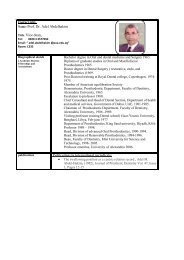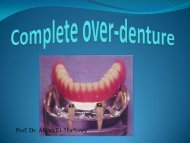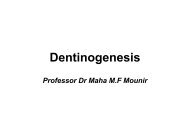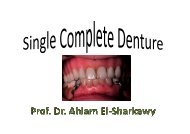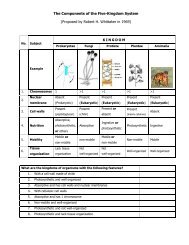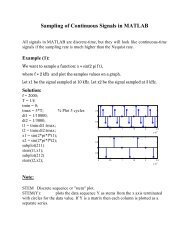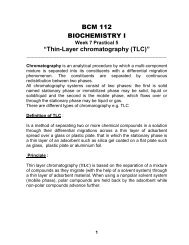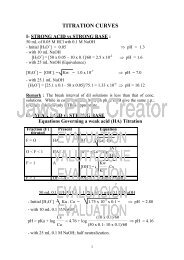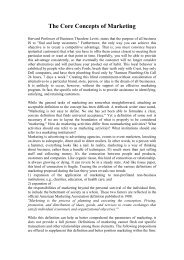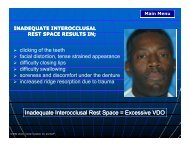Mandibular PREMOLARS
Mandibular PREMOLARS
Mandibular PREMOLARS
You also want an ePaper? Increase the reach of your titles
YUMPU automatically turns print PDFs into web optimized ePapers that Google loves.
<strong>Mandibular</strong> <strong>PREMOLARS</strong>
Chronology<br />
First evidence of calcification<br />
Enamel completed<br />
Eruption<br />
Root completed<br />
1 ¾ to 2 yr<br />
5 to 6 yr<br />
10 to 12 yr<br />
12 to 13 yr
<strong>Mandibular</strong> First Premolar<br />
Buccal Lingual Mesial<br />
Distal<br />
Occlusal
MANDIBULAR<br />
FIRST PREMOLAR
Geometric Outline of the Crown<br />
Facial and lingual aspects have<br />
trapezoid out line.<br />
The smallest of the<br />
uneven sides<br />
È<br />
cervically.
q Outlines:<br />
• Mesial and distal outlines:<br />
are nearly concave<br />
• Mesial and distal cusp slopes:<br />
are also slightly concave<br />
Buccal Aspect<br />
Bucc. cusp<br />
pointed<br />
and long<br />
Contact areas:<br />
Are almost of the same level<br />
M<br />
D<br />
Cervical line:<br />
convex root wise.
q Surface anatomy of the crown<br />
Elevations:<br />
• The surface is convex with<br />
maximum convexity at C 1/3<br />
representing cervical ridge<br />
Buccal Aspect<br />
• The middle lobe is convex<br />
buccally forming prominent<br />
BUCCAL ridge.<br />
Depressions:<br />
§ Shallow depressions are<br />
present mesial and distal to<br />
the buccal ridge.
q Outline and Surface Anatomy<br />
of the Root<br />
Buccal Aspect<br />
The M and D outline of<br />
the roots tapered to a<br />
pointed apex that curved<br />
distally.<br />
The surface of the<br />
root is convex and<br />
smooth
Lingual convergence:<br />
Lingual s. is narrower than buccal s.<br />
q Outlines:<br />
• M and D outlines are concave<br />
• The L cusp is short and small<br />
reaching 2/3 the crown length<br />
and has a pointed tip.<br />
Cervical line: is convex root wise.<br />
q Surface Anatomy :<br />
Elevations: The lingual surface is convex<br />
with maximum convexity at middle 1/3<br />
Depessions: ML developmental groove at<br />
the ML line angle.<br />
Lingual Aspect
Proximal Aspects<br />
l Proximal aspects have<br />
rhomboid shape<br />
Mesial<br />
Distal<br />
With narrow<br />
occlusal table<br />
prominent<br />
lingual inclination
Mesial<br />
Aspect<br />
q Outlines of proximal aspects<br />
Distal<br />
Aspect<br />
Buccal outline is convex with maximum convexity at<br />
C 1/3 representing cervical ridge.<br />
Lingual outline is convex with maximum convexity at<br />
middle1/3<br />
Cervical line curves occlusally and less curved distally
Mesial<br />
Aspect<br />
Distal<br />
Aspect<br />
Occlusal margin:<br />
The two cusps are not on the same level<br />
The lingual cusp is shorter by 1/3 length of crown<br />
The B cusp centered over the root. This is due to<br />
the prominent lingual inclination.<br />
The L cusp tip in line with lingual border of the root.
Mesial<br />
Aspect<br />
Distal<br />
Aspect<br />
MMR inclined from<br />
B to L surface // to<br />
B cusp ridge.<br />
(unique characteristic of<br />
this tooth).<br />
DMR is straight and at<br />
right angle to the axis<br />
of the tooth.<br />
DMR is occlusal than<br />
MMR
Mesial<br />
Aspect<br />
q Proximal surface anatomy<br />
Distal<br />
Aspect<br />
M & D surfaces are smooth & convex except for a<br />
concave area cervical to contact area.<br />
Contact areas: nearly at same level<br />
Mesio-ling. dev.gr.<br />
present at the junction<br />
of Lg and M surfaces.<br />
Contact area is broader,<br />
more cervically and<br />
facially positioned.
Mesial<br />
Aspect<br />
q Outline of the Root<br />
Distal<br />
Aspect<br />
B & L outlines are nearly straight cervically<br />
then taper to apically to a pointed apex<br />
The surface is more<br />
convex<br />
The surface is smooth<br />
and flat with deep<br />
developmental groove
Occlusal Aspect<br />
It’s diamond-shaped.<br />
Lingual convergence is sharp.<br />
Mesial outline is slightly curved.<br />
Distal outline is more convex.
q Surface anatomy of occlusal aspect:<br />
Elevations:<br />
B triangular ridge.<br />
L triangular ridge.<br />
M & D marginal ridges<br />
Transverse ridge
Depressions:<br />
Central dev. groove<br />
M and D triangular fossae.<br />
Mesio-lingual<br />
developmental groove
PULP CAVITY<br />
Buccal p. horn: more<br />
Pronounced than the<br />
lingual.<br />
Cross sec. At the cervix:<br />
rounded or oval
MANDIBULAR<br />
FIRST PREMOLAR
<strong>Mandibular</strong><br />
Second Premolar
<strong>Mandibular</strong> Second Premolar:<br />
Two Cusp Type<br />
Buccal Lingual Mesial<br />
Distal<br />
occlusal
<strong>Mandibular</strong> Second Premolar:<br />
Three Cusp Type<br />
Buccal Lingual Mesial<br />
Distal<br />
occlusal
•<br />
• First evidence of calcification<br />
• Enamel completed<br />
• Eruption<br />
• Root completed<br />
2 ¼ to 2 ½ yr<br />
6 to 7 yr<br />
11 to 12 yr<br />
13 to 14 yr
Comparison between<br />
Maxillary First and Second Premolars<br />
Geometric outline of the crown<br />
Facial and lingual aspects have<br />
trapezoid shape<br />
But wider<br />
cervically<br />
than 4.
Facial Outlines and surface anatomy<br />
<strong>Mandibular</strong> First Premolar<br />
<strong>Mandibular</strong> Second Premolar<br />
B cusp<br />
pointed and long<br />
Prominent B ridge<br />
Pointed apex<br />
B cusp<br />
short and less pointed<br />
Not well prominent B<br />
ridge<br />
Blunt apex
Lingual outline and surface anatomy<br />
<strong>Mandibular</strong> First Premolar <strong>Mandibular</strong> Second Premolar<br />
Two cusp<br />
type<br />
The L cusp is short and small<br />
reaching 2/3 the crown length<br />
and has a pointed tip.<br />
The lingual surface is convex<br />
with maximum convexity in<br />
middle 1/3<br />
ML developmental groove at<br />
the ML line angle.<br />
L cusp is shorter and<br />
smaller than B cusp but<br />
larger than of 4<br />
The surface is convex<br />
with maximum convexity<br />
in Occ.1/3.<br />
No MLDG
Three cusp type:<br />
ML cusp is longer and wider than<br />
DL cusp. They both shorter than<br />
B cusp and less pointed.<br />
The surface convex with<br />
maximum convexity at Occ.1/3.<br />
M<br />
D<br />
The L developmental groove<br />
between the 2 cusps
<strong>Mandibular</strong> First Premolar<br />
Proximal outlines<br />
<strong>Mandibular</strong> Second Premolar<br />
Rhomboid in shape with<br />
narrow occlusal table.<br />
Prominent lingual<br />
inclination<br />
Rhomboid in shape with<br />
narrow occlusal table.<br />
Lingual inclination<br />
less prominent
<strong>Mandibular</strong> First Premolar<br />
<strong>Mandibular</strong> Second Premolar<br />
Maximum convexity at M1/3 Maximum convexity at O 1/3<br />
The L cusp is short and small<br />
reaching 2/3 the crown length<br />
The B cusp centered over<br />
the root.<br />
The mesial MR is oplique<br />
while distally is straight<br />
L cusp is shorter and<br />
smaller than B cusp but<br />
larger than that of 4<br />
B cusp tip on line with junction<br />
of B & M 1/3 of the root.<br />
The mesial and distal<br />
marginal ridges are straight
Mesial<br />
Aspect<br />
Three Cusp<br />
Type of<br />
<strong>Mandibular</strong><br />
Second<br />
Premolar:<br />
Distal<br />
Aspect<br />
ML cusp is longer and<br />
larger than DL cusp.<br />
DL cusp is shorter and<br />
smaller than ML cusp.<br />
Both lingual cusps are shorter than the buccal cusp<br />
and less pointed
Occlusal Aspect<br />
<strong>Mandibular</strong> First Premolar <strong>Mandibular</strong> Second Premolar<br />
Two cusp type:<br />
Diamond-shaped.<br />
Lingual<br />
convergence is<br />
sharp.<br />
U- shaped H - shaped<br />
The outline is oval<br />
Slight lingual convergence<br />
Three cusp type:<br />
The<br />
outline is<br />
square
Surface Anatomy of Occlusal Aspect:<br />
Lower 4<br />
Lower 5<br />
Two cusp type<br />
Elevations:<br />
B triangular ridge.<br />
L triangular ridge.<br />
Transverse ridge<br />
M & D marginal ridges
Lower 4<br />
Lower 5<br />
Two cusp type<br />
Depressions:<br />
Central developmental groove<br />
M and D triangular fossae.<br />
Central developmental groove<br />
H or U shaped.<br />
M and D triangular fossae.<br />
Mesiolingual<br />
developmental groove
Lower 5 :<br />
Three cusp type:<br />
Elevations:<br />
Buccal triangular ridge.<br />
Lingual triangular ridges<br />
of lingual cusps<br />
(ML & DL).<br />
M & D marginal ridges<br />
Depressions:<br />
Central developmental groove<br />
Y shaped<br />
M and D triangular fossae.
MANDIBULAR<br />
SECOND PREMOLAR<br />
3 cusp type<br />
2 cusp type
PULP CAVITY



